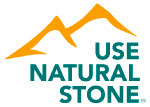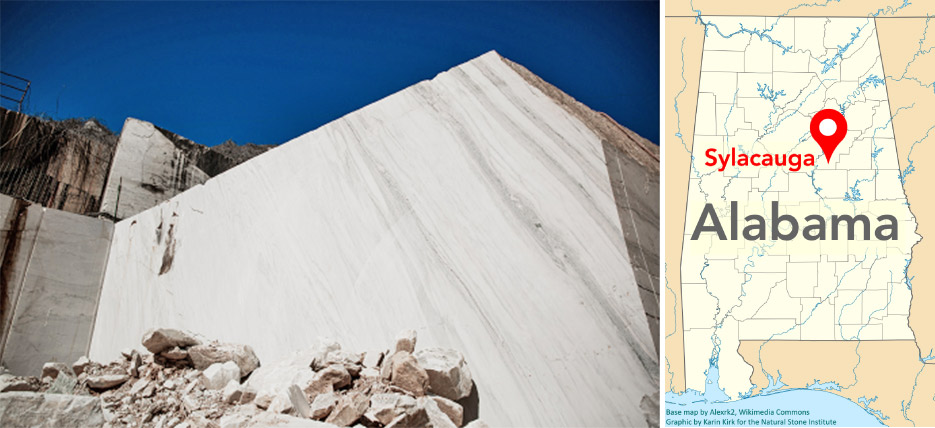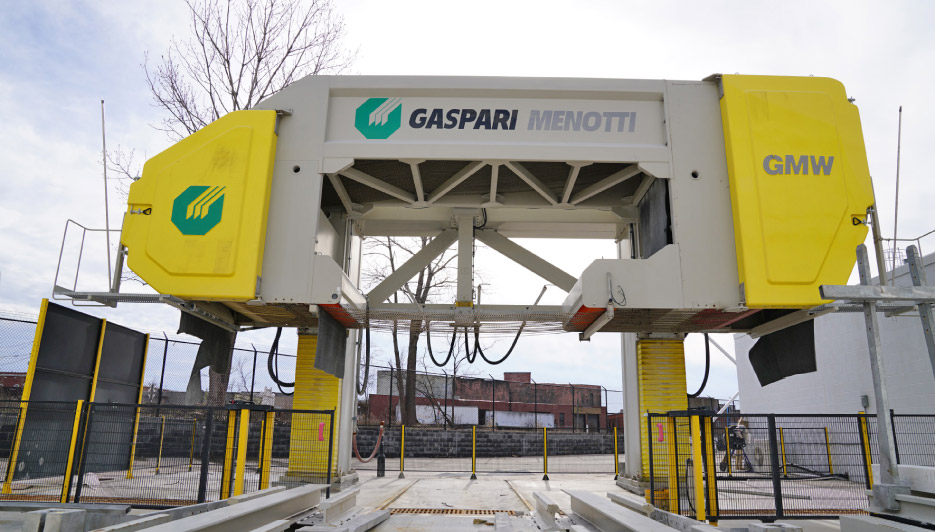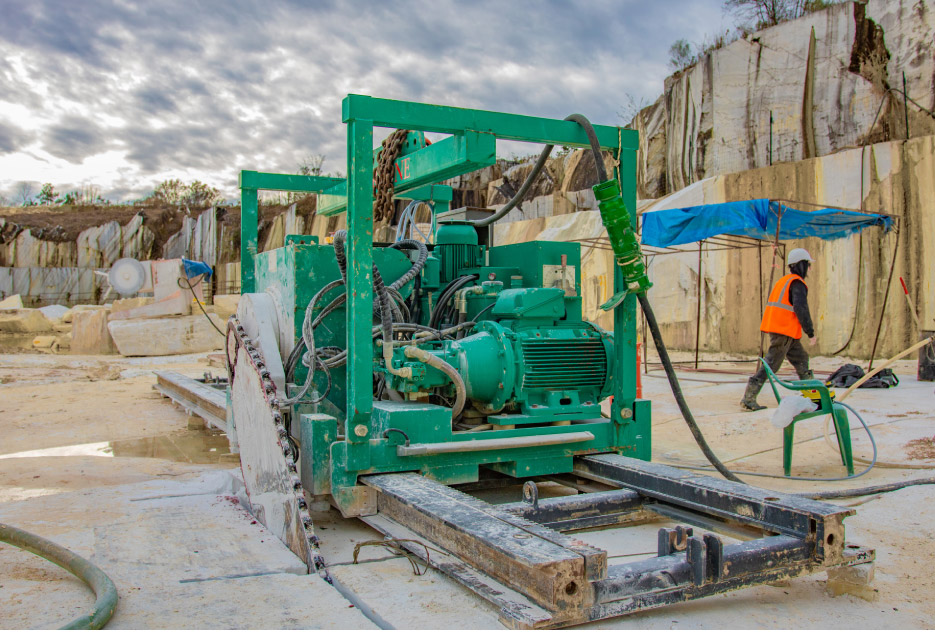American Stone, High-End Aesthetics and Alabama Jobs at AM3 Stone
 Karin Kirk
Karin Kirk
usenaturalstone.com
Diagrams © Karin Kirk.
Photos Supplied Courtesy AM3 Stone
Oceans may seem like permanent features, but it turns out they’re not. Ocean basins open and close throughout geologic time, pushing continents apart, then drawing them back together as geologic forces continually reshape the map of the world.
Today’s Atlantic Ocean is relatively new, if you consider something that’s 200 million years old to be “new.” Before the Atlantic Ocean existed, the world’s land masses were all locked together, in a vast supercontinent called Pangea. As Pangea formed, Africa and Europe slid into the east coast of North America, rippling up an enormous mountain chain similar to today’s Himalayas. Over eons, the jagged, high-altitude peaks were smoothed down to become gentle ridges and valleys, otherwise known as today’s Appalachian Mountains.
The Appalachians are a sinuous zone of rocks stretching from Vermont to Alabama that bear the distinct signature of an ancient continental-scale collision. Most of the rocks have been heated, stretched, and deformed. Formerly flat-lying sedimentary rocks now jut up at an angle like a wrinkle in a carpet, creating long ridgelines. In some cases, older rocks have been heaved up and placed on top of younger rocks, disobeying the normal rules of geology and probably confusing the heck out of early geologists.
The Talladega slate belt is one such example of a geologic reshuffling. This section of rocks moved as much as 75 miles from its original root, sliding inland and overriding younger layers, much like a snowplow lifts older, deeper layers of snow and shoves them on top of fresher, newer layers.
The result was a fortuitous gift to Alabama and southern Georgia, in the form of a deposit of sparkling white marble. In Alabama, the Talladega slate belt contains the Sylacauga Marble, a compilation of layers 8,000 feet thick. The choicest section is called the Gantts Quarry Formation, which beholds pure, fine grained calcite marble. The collision that produced the stone thrust it into near-vertical layers, with veins and swirls of mica minerals folded into the calcite.
 |
|
Alabama marble was used to build the Supreme Court, the ceiling of the Lincoln Memorial, and Penn Station, among scores of other notable national projects. |
New Life for an Old Quarry
The white stone drew the attention of Dr. Edward Gantt, a physician and sculptor who opened the first quarry in the area in 1834. Other quarries soon followed and for nearly 200 years, Alabama marble has been used for sculpture, architecture, and industrial applications. The stone was used to build the Supreme Court, the ceiling of the Lincoln Memorial, and Penn Station, among scores of other projects.
But as with many historical stones, the prosperity of Alabama marble was never assured, and at times its production idled.
In 2013, the stone was revitalized by new investment, a fresh team, and a renewed sense of purpose and energy. A new company was born: Alabama Marble, Mineral & Mining, dubbed AM3 Stone for short. AM3 invested in an inactive quarry, ramping up production once again. For American consumers, the resurgence of Alabama marble brings a new option of a locally-derived stone with in-house fabrication abilities and straightforward domestic shipping.
Alabama marble offers one more, intangible yet important detail: a sense of satisfaction. Emily Dykes is a native Alabaman and the Marketing Director at AM3. “There’s a lot of Alabama pride when it comes to this material,” she says with a broad smile.
The quarry sits just outside Sylacauga, Alabama, dubbed the “Marble City.” Sylacauga celebrates its historic stone with an annual marble festival, and the community members are “champions of the marble” says Dykes.
 |
|
The Talladega slate belt also contains the Sylacauga Marble, a compilation of layers some 8,000 feet thick. The Gantts Quarry Formation holds pure, fine grained calcite marble. |
 |
Italian Know-How with an American Workforce
AM3 Stone is run by an international team that knits together expertise from across the globe “We are a new player in the industry,” says Bintao Qin, Vice President of Operations. The company completed a sparkling-new fabrication facility in 2016, and opened a showroom in Birmingham. Pairing quarrying with fabrication and design services makes the company “a one stop shop,” says Qin.
Giuseppe Telara is AM3’s Business Development Manager; he’s an architect who grew up among the famous “marble mountains” in Carrara, Italy. “I’ve been in this business since I was a kid. My family has been in this business for four generations.” Parts of the AM3 quarry “are like the Calacatta material from my hometown,” he says with reverence. “Alabama marble is a beautiful material.”
Dykes hails from a fine arts and architectural design background, as is evident in her descriptions of the stone: “The color and composition of our stone, the grain of it, it’s so beautiful when cut,” she says. “It’s a work of art within itself.”
The team at AM3 offers no shortage of enthusiasm and ambition as they strive to help this American stone reach its full potential.
Italian Quality at Domestic Pricing
Through the ages, Italy has been synonymous with quarrying and using white marble, but today Americans are the main buyers of Italian marble. Telara explains that 70 to 80 percent of Carrara’s marble is currently being exported to the US.
That arrangement has major drawbacks. Long-distance shipping adds cost and raises the energy footprint, and the faraway supply chain can make lead times long and unpredictable. Furthermore, the high demand for Carrara marble typically means it commands a top price.
AM3’s solution to these problems is to invest in a resource that’s closer to the end customer. By developing an American stone for the American market, production times are shorter. “We’re not having to ship from overseas. Everything comes right through us, and it can go out very quickly,” says Dykes.
Telara sings the praises of the merging of the cultures. “We are processing the stone with Italian equipment. Everything we have in the factory is Italian, all the top-of-the-line machinery both in the quarry and in the factory.” To run that machinery, the company trained a new workforce and grew local jobs, bringing simultaneous benefits to the local economy and the end consumer. Because of its local production, Telara says the price point of Alabama marble is considerably less than its Italian counterpart, “and the quality is the same.”
With the facility running smoothly, the team’s next step is to spread the word. Dykes explains, “Right now we’re working really hard to get the product out there and let designers across the nation know that this is an option. This is Italian quality at domestic prices,” she says. “We can fill that need.”
 |
|
Processed slabs of Alabama White, a fine-grained marble with dramatic mica swirls that rivals Cararra in quality – at “domestic” prices. |
‘A Big Push’ for Sustainable Products
A major advantage of American-made products is they tend to have better environmental footprints compared to imported products. “The environmental regulations here are pretty strong, whereas if you process in other places, it’s not the same,” says Dykes. “We do a good job of making our product as sustainable as possible.”
Dykes sees an increased demand for sustainability coming from the architectural community. “There’s a big push for sustainable products and to build as green as possible,” she says.
The company intends to pursue certification to the Natural Stone Sustainability Standard in the near future, and they’re already upping their game. “We use 98 percent recycled water in our processing facility and quarry,” says Qin.
Stone that’s not suited for fabrication is crushed and sold for calcium carbonate powder, which can be used to make toothpaste, paint, abrasives, antacids, and an additive in paper. Telara explains, “by using marble power for making paper, they can use less wood.”
By repurposing more of the quarried material, the company has less waste to dispose of, and an additional product to sell. For both environmental and business reasons, “we try to use everything we can use,” says Qin.
Boom in Residential Projects
The COVID-19 crisis hasn’t stymied the company’s efforts to grow. “We’re a small company but we’re growing, even during the pandemic,” says Qin. “Construction business is actually not bad,” he says. “The residential side is booming during COVID.”
Dykes sums up the pent-up demand for kitchen, bathroom, and other residential work as we wait out the pandemic. “We’re all sort of looking around our houses and saying, ‘hmm what needs to be done here?’”
Meanwhile, Telara keeps his eye on the geology. “We’re getting more into the good material,” he says, as they quarry deeper and find new colors. Because of the collision-style tectonics that created the marble, “the veining is almost vertical, at a 70-degree angle,” explains Telara. He’s pleased with the way the quarrying is taking shape. “The newest blocks are more sound; we’re getting bigger blocks; nicer blocks,” he says.
“The quarry is 10 meters (33 feet) deep right now,” Telara says, and the deposit is estimated to be 400 feet deep. The 50-acre property offers lots of options for expansion “We can expand it and go down at the same time.”
‘It’s Like Christmas’
A big part of Telara’s job satisfaction has been watching the employees learn new skills and build their sense of pride in their work. “Every time you cut a block on a gangsaw, it’s like Christmas,” he says. “Because you never know. You can see the outside but you never see what’s inside. Sometimes you get the most beautiful block. It’s a big satisfaction when you see it.”
“American people like American materials,” says Telara. “They’re proud of it.” He adds, “The fact that it’s an American material helps a lot. That makes the customers go and look for it, in a big way.”
Dykes nods in agreement. “I’m originally from Alabama, we get a lot of slack for being Alabamans” she says. “It’s such an amazing stone and I’m really proud that I get to be the person to bring that to the rest of the nation.”
Karin Kirk is a geologist and science educator with over 20 years of experience and brings a different perspective to the stone industry. Karin is a regular contributor to usenaturalstone.com and the Slippery Rock Gazette. Contact her at karinkirk@gmail.com .
Note: This article is part of a series about American quarries. If you work for a quarry that’s a member of the Natural Stone Institute and you’d like your quarry to be featured here, contact Karin Kirk. Thank you!